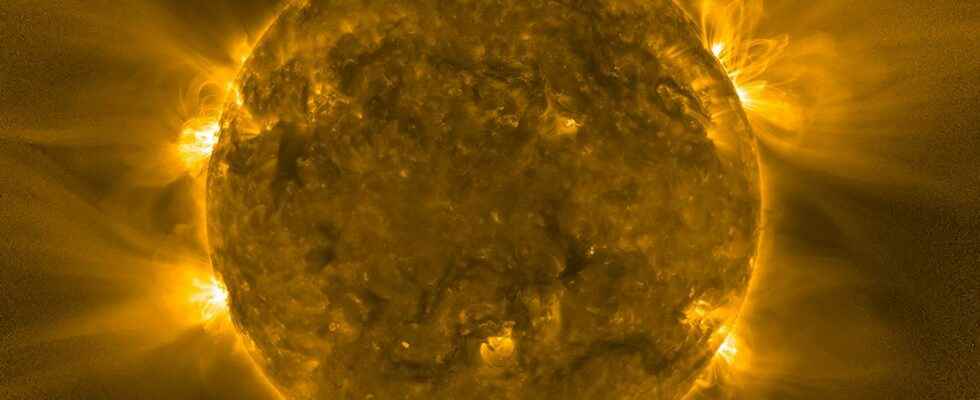The theory of stellar structure and evolution which flourished with the development of theastrophysics nuclear just after the Second World War, and of which we can have a glimpse with Martin Schwarzschild’s treatise (Karl’s son, famous for his solution of equations ofEinstein describing a black hole), is final as to the future of stars as the Sun : in about five billion years, our star will turn into red giant and its upper layers will expand. It’s not just a theory, observations of the hundreds of billions of stars in the Milky Way show it to us with stars that are cousins of the Sun but older than it.
Calculations suggest that our Star will swell so much that it may well swallow up to Earth. Our Blue Planet will have become unlivable a few billion years before because its oceans will have evaporated due to an already inexorable increase in the brightness of the Sun. But what else could happen once inside the Sun’s dilated outer layers?
The power of computers and the improvement of digital techniques allow us today to begin to answer this question, as shown in a publication in The Astrophysical Journal which can be found on arXiv.
Its main author, Ricardo Yarza, is a doctoral candidate in astrophysics at the University of California at Santa Cruz. His work was developed with the help of Enrico Ramirez-Ruiz, professor of astronomy and astrophysics, and Dongwook Lee, Associate Professor of Applied Mathematics, both at UC Santa Cruz.
Like living beings, stars have a life cycle. They are born inside a cloud of gas and dust, they live their lives by fusing hydrogen into helium in their nuclei, shining and stable as long as that hydrogen lasts. Then they die, each in their own way. The death of a star depends on its mass. The bigger they are, the shorter will be their life and the more sublime will be their death. What exactly will happen when the Sun dies? To obtain a fairly accurate French translation, click on the white rectangle at the bottom right. The English subtitles should then appear. Then click on the nut to the right of the rectangle, then on “Subtitles” and finally on “Translate automatically”. Choose “French”. © PBS SpaceTime
What the simulations reveal
The aim was to make a partial simulation of the fluid flow of the outer layers of a star in the red giant phase around a planet of the size and mass data. The fluid can exert frictional force so that it can change theorbit of the planet and in return, theenergy dissipated by friction and coming from the movement of the planet around the star is likely to modify the state of the layers of the latter to the point of causing the dissipation of its upper envelope.
Finally, as explained in a press release from UC Santa Cruz, the simulations show that the interactions of a planet or a brown dwarf with the gas hot in the outer envelope of a Sun-like star can lead to a range of results depending on the size of the engulfed object and the stage of the star’s evolution.
In this press release, Ricardo Yarza specifies that “ evolved stars can be hundreds or even thousands of times larger than their planets, and this disparity in scales makes it difficult to perform simulations that accurately model the processes physical occurring at every scale. Instead, we simulate a small section of the star centered on the planet to understand the flux around the planet and measure the drag forces acting on it. “.
The stars, swallowers of planets
After his phase of red giantour Sun will contract to become a white dwarfits mass should then be contained in a dense sphere of matter degenerate the size of the Earth. However, it happens that we observe white dwarfs with exoplanets and brown dwarfs in close orbits. It has been suspected for some time now that it is precisely the drag forces exerted by the gas of the red giant phase that has caused the orbits of these stars which therefore approached the central star just as in the case of the Earth; it can be seen and calculated that the frictional forces of the high atmosphere on satellites can be enough to cause them to fall.
The results already obtained with the simulations of Ricardo Yarza and his colleagues can help to specify the analogue of this phenomenon with a star in the red giant phase.
According to the calculations of these astrophysicistsno substellar body less than about 100 times the mass of Jupiter cannot eject the envelope of a Sun-like star until it has expanded to about 10 times the radius of the Sun. At later stages of stellar evolution and expansion, however, the stellar envelope could be ejected by an object as small as ten times the mass of Jupiter, reducing its orbit by several orders of magnitude in the process.
The researchers also found that planetary engulfment can increase the brightness of a Sun-like star by orders of magnitude over several thousand years.
Only a few days left to take advantage of our special offer for Father’s Day!
Your father is a great science enthusiast and unusual discoveries? And if you offer him a superb scientific exploration in paper format? Benefit from -20% on the Mag Futura (special offer: €15 instead of 19 €): 220 pages, 4 key issues deciphered to understand everything about the science that will mark 2022.
Special offer: -20% reduction on the Mag Futura
Mag Futura is:
- 4 major scientific questions for 2022, from the Earth to the Moon
- 220 pages, 60 experts
- Home delivery
- Electronic gift card
Interested in what you just read?
